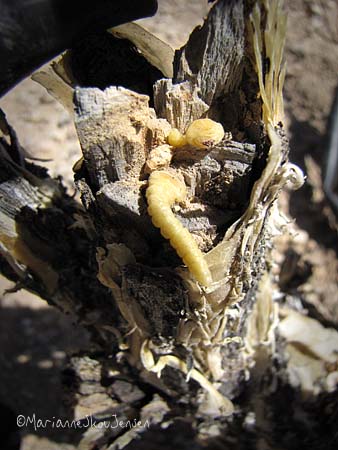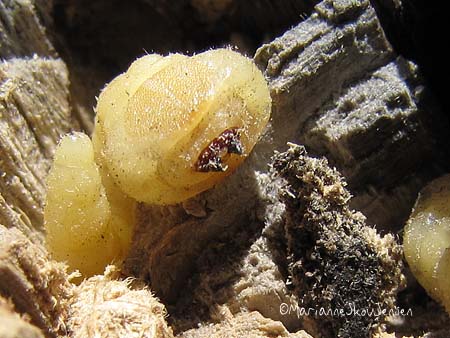One of our largest Ocotillos was taken by flat head borers 🙁 . This guy was right outside the dining room window and has been used as a resting spot for many birds much to the delight of our cats. I’m especially sad to see it go as it’s been the source of some of my best bird and sunrise shots.

It had been under stress ever since it had to be moved when the house was built. Then last year a micro burst blew it over and since then, it hasn’t looked good. If I had looked closer, I would have seen little holes up and down the stalks. I started snapping off the obvious dead stalks and this is what I found. Ewwww!

Lesson? If some of your Ocotillo stalks haven’t leafed out while neighboring stalks have, start looking for small round holes. If you see these holes, you likely have an infestation of Ocotillo borers.

Tag Archives: borer
A Boring Insect
![]()
Ahhh….if I knew then what I know now about selecting trees, this little Sweet Acacia (Acacia farnesiana) would never have been planted in my yard. I bought it because it was over 12 feet tall and had a 3 1/2 in trunk which meant instant shade! What I know now is that you should always be suspicious of the condition of the roots when you buy a tree this size especially if you find it at the back of a big tree farm!
In the two years that it’s been planted here, it showed only minimal sign of growth and when I would push against the trunk, the tree rocked back and forth. My new found knowledge from my desert landscaping course made me suspect that the roots were circling. This can happen from being boxed out of the ground too long and I was right. Circling roots never allows any outward root growth so besides not getting a strong hold in its new location, it can’t send out new feeder roots which means it doesn’t get proper nourishment. Ultimately, it gets weaker and very stressed which makes it very attractive to wood boring insects like the one pictured above.
So I bit the bullet and removed it yesterday. (actually took me two days of sawing limbs and then the trunk). As I started sawing, I noticed small holes at the bottom of the trunk and knew what they were. I dug an insect out of the hole shown above. Sadly, (for my photo op), the head came off. Had I known how pretty it was going to be, I would have been so much more careful! Ted C. MacRae at BugGuide.net identified it as a Buprestidae but couldn’t identify the exact species. This website is great, by the way. If you’re at all curious about insects in your garden/yard, check it out. You can upload a photo and then request an ID.